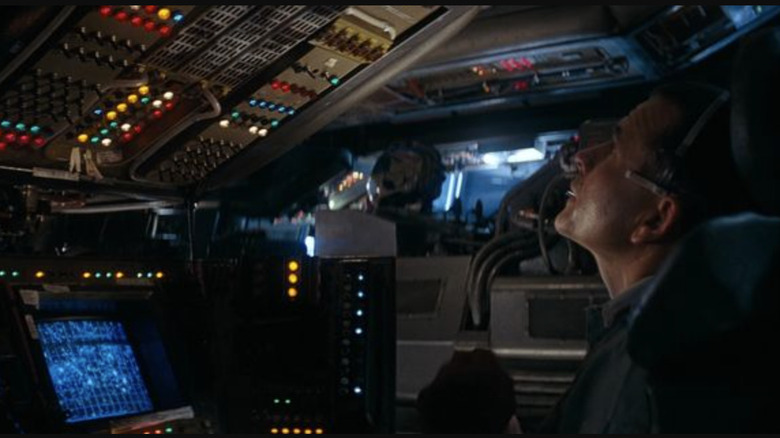The Fascinating Reason An Alien Easter Egg Was Axed From Star Trek Beyond
It's generally understood how every element of a film contributes to its overall effect, and that changing even the tiniest detail can make or break a particular moment. Even so, sometimes it takes some experimenting to see just how and why something may or may not fit into the overall fabric of a movie, because you never know until you try. This principle can be trickier when attempting to experiment with a franchise, especially one as long-running and well-established as "Star Trek." Yet J.J. Abrams managed to stretch "Trek" past its usual parameters when he mounted his 2009 reboot/legacy/alternate "Kelvin" timeline feature, giving the franchise a much-needed burst of new aesthetic energy while retaining many of its core principles. After all, who ever thought that a Beastie Boys song would fit neatly into "Trek?"
It's in this spirit that the two follow-up films, Abrams' "Star Trek Into Darkness" and Justin Lin's "Star Trek Beyond," continued, with each subsequent movie finding new ways of jazzing up the continuing mission of the Starship Enterprise and its crew. While the Kelvin trilogy managed to sneak many new and remixed elements into "Star Trek," apparently some just didn't vibe with the franchise. This was discovered by o-supervising sound editor Lee Gilmore, who recently spoke with /Film's BJ Colangelo at the activation for "Alien: Romulus" at L.A.'s Haunted Hayride (this writer was also present). While speaking about "Romulus," for which Gilmore acted as supervising sound editor, the sound artisan discussed how he tried to sneak an "Alien" Easter egg into "Star Trek Beyond," but ended up having to lose the idea given the very different aesthetic intentions of each franchise.
Gilmore tried to work Nostromo noises into 'Star Trek Beyond'
One of the most recognizable, signature sonic elements of Ridley Scott's original "Alien" from 1979 is the sound design, which includes a library of familiar yet unsettling sounds that the commercial towing vehicle Nostromo makes throughout the movie. The vessel, acting as both home, workplace, and protective cocoon for its complement of seven humans soon becomes a terrifyingly Gothic old dark house once a Xenomorph is unwittingly brought aboard. This changing identity of the ship, as well as the potential threat(s) it may be harboring, was ingeniously worked into the sound design, something which Gilmore appreciated so much that he attempted to pay homage to it when designing the sounds for "Star Trek Beyond." Sadly, this attempt did not end up working out, as Gilmore recalled to Colangelo:
"[The Nostromo boot-up sequence has] been my favorite forever and I loved it so much that I tried to kind of recreate my own version. 10 years ago I was working on 'Star Trek [Beyond]' and I'm like, 'Let me try to do my own boot-up sequence.' And it doesn't work for 'Star Trek' at all because 'Star Trek' is shiny and pretty and all this stuff. So I had all these kinds of boot-up sounds just sitting on a hard drive for 10 years that I finally got to use. But that original Nostromo boot-up is just like, every time I listen to it, I just smile. It gives me goosebumps. They're just weird sounds. It doesn't sound like computers."
Indeed, it's equally understandable why Gilmore tried to make the boot-up homage sounds work in "Beyond" as to why they didn't end up fitting. After all, boot-up noises are computer noises, and there are various vehicles and computers in "Beyond" that could ostensibly make whatever noises the filmmakers would wish. Yet the particular tone and cadence of those Nostromo noises were engineered to fit into the world of "Alien," which is relentlessly hostile, an aesthetic that just doesn't jive with "Star Trek," no matter how much of a gritty spin was put on it. The Beastie Boys are as edgy as "Trek" goes, it seems!
Gilmore finally got to play with Nostromo noises in 'Alien: Romulus'
Fortunately for Gilmore, he got his chance to mess around with and pay homage to the Nostromo sounds he'd always loved when he was hired to work on "Alien: Romulus." As he told Colangelo, "Being able to have the chance to [make those sounds] on our own with the Echo Probe was just a dream come true." Anyone who's seen "Romulus" knows that Gilmore didn't skimp on his opportunity, as the Echo Probe booting up is the first major jumpscare of the entire movie. For further proof of the lengths Gilmore went to properly homage "Alien," the sound designer elaborated to the assembled group present at the activation about how he and his team put a lot of effort into making their Nostromo-esque sounds come to new life:
"We just tried to recapture the same vibe as '79, you know? We didn't want to get it to where we were like reusing a lot of the same sounds, because I kind of felt like you were cheating a little bit. So we really did a deep dive on, how do we recreate all these sounds? Like, the Nostromo booting up is like my favorite sound moment, period. So in order to have our own version of the Echo Probe start up, it was like an amazing opportunity to try to recreate all this kind of sound without just copy and pasting. So it was just a lot of deconstruction, trying to figure out sounds that sounded similar to the original '79 stuff. [...] Like, it's a test the vibe check. So if anything sounds too modern, too flashy, we just get rid of it. So we want everything to sound really analog, breaking apart at any second, really electromechanical."
To be clear: I'm not saying that "Star Trek" isn't or cannot be scary. I mean, heck, we've all seen the Ceti eels from "The Wrath of Khan." It's just that the world and aesthetic of "Alien" is thoroughly unfriendly to benevolent life, whereas "Trek" is all about finding ways around and/or through antagonism. So it tracks that the franchises cannot quite share the same sonic space, and hey, it's clearly not for lack of trying. So while no one should get their hopes up for a "Star Trek vs. Alien" crossover, we can take heart that we have artists like Gilmore, who get to keep the legacies of such franchises well intact.


